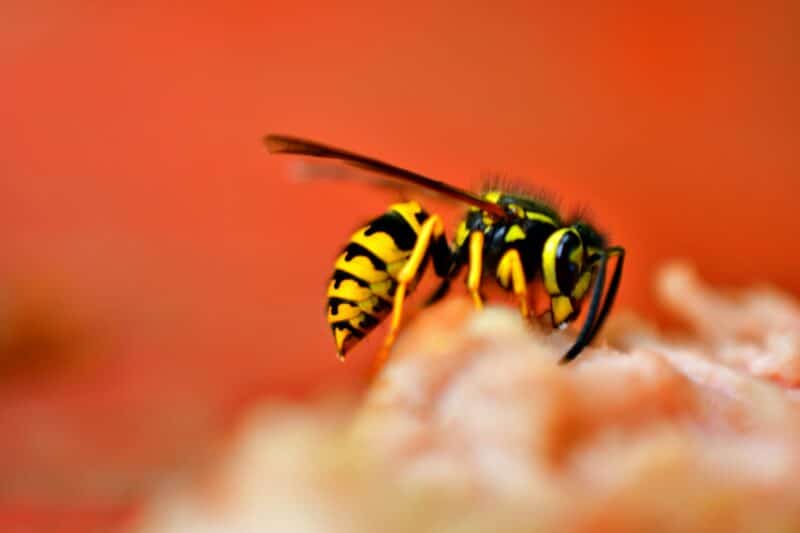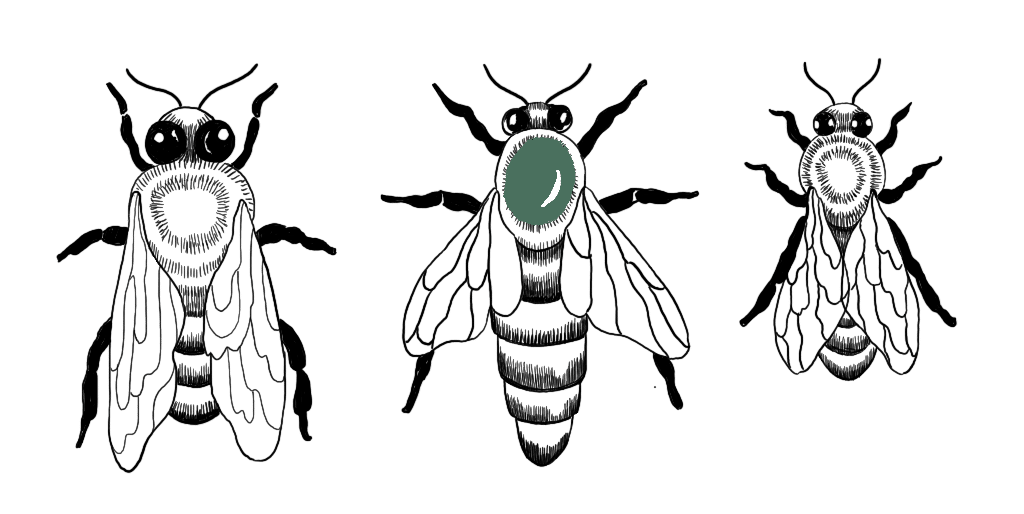Contents:
- The Different Types of Bees
- The Seven Distinct Bee Families
- How to Identify Bees
- The Difference Between Bees and Wasps
- 14 Different Types of Bees
- Honey Bee Hive Hierarchy: The 3 Roles in a Hive
- How to Attract Different Types of Bees
- How to Help Support the Health of All Types of Bees
- FAQs
When thinking of bees, many picture golden honeybees that forage on flowering plants and produce delicious honey within a hive–but bees are an immensely diverse species, and honeybees are just one part of an estimated 20,000 types of bees! The topic of bee species, their behaviors, and how we can help improve the overall population is something The Best Bees Company is very passionate about. So much so that Co-Founder and Chief Scientific Officer Noah Wilson-Rich even wrote a book titled The Bee: A Natural History.
–– Interested to know how the bees are doing? Download our State of the Honey Bee Report now ––
In this post and thanks to the information provided by Noah’s book, we will go over the various types of bee families, types of bees, how anyone can not only identify and attract these pollinators, but how you can help them, too.
The Different Types of Bees
The global abundance of flowering plants from about 100 million years ago opened up a world of opportunity for the vegetarian wasps we now know as bees. Adaptive radiation proliferated across the globe, which meant that different types of bees evolved as they matched the wide variety of environments, habitats, and flowers.
The estimated 20,000 species of bees are classified into seven distinct families, which can be divided into three broad groups according to the average length of the bee’s tongue, called a proboscis. The long-tongued bees sip nectar from deep within the floral chambers, while the shorter-tongued bees tend to be more ancient, more closely resembling their carnivorous wasp ancestors.
The Seven Distinct Bee Families
Biologists classify all bee species into the Apidae, Halictidae, Megachilidae, Andrenidae, Colletidae, Melittidae, and Stenotritidae families. Read more about these families below and see which broad group they fall into.
Short-Tongued Bees
Andrenidae: Mining bees, found in temperate, arid, warm climates. Wasp legacy visible in facial structure eyebrow-like colored patterns, males with facial hair, which might be used for recognition of individuals, but Andrenidae have more advanced eyes. Nest in simple soil burrows, or in hives that require multimodal communication to achieve complex architecture.
Colletidae: Plasterer bees, masked bees, yellow-faced bees, polyester bees. Typically Australian, with some species in South America and a few in North America and Europe. A unique two-part tongue is used to create remarkable nest burrows lined with smooth secretions. Some transport pollen by swallowing and regurgitating it, rather than by carrying it outside their bodies like most other bees, while other Colletidae carry pollen on leg hairs. Can have large ocelli (simple eyes), helping them to see in dim light.
Stenotritidae: The smallest family of bees. Australian. Similar to Colletidae, but with one mouthpart instead of Colletidae’s distinct two. Nest in burrows underground. Large and fuzzy.
Medium-Tongued Bees
Melittidae: Primitive family, the least changed of all bees since the split from wasps. Found mainly in Africa. Tend to be picky specialists concerning their food source, sometimes forgoing pollen for flower oils. They are solitary and ground-nesting.
Halictidae: Sweat bees found worldwide. Often attracted to sweat. Small. Can be colorful and do sting. Nest underground in soil or sand. Highly social, but there are also solitary Halictids. Their range of social systems makes them a fascinating group to use for studying the evolution of social living.
Long-Tongued Bees
Apidae: Largest bee family, made up of over 5,700 species. Believed to date back as far as 115 million years ago; the oldest known fossilized bee is from this family. Cuckoo, carpenter, digger, bumble, stingless, and honey bees that are found worldwide. With or without functional ovipositor (sting). Solitary to eusocial, some even parasitizing other bees by stealing their resources (kleptoparasitism), such as cuckoo bees, which lay their eggs on pollen collected by their host bees. Some make products that are used by humans.
Megachilidae: Leaf-cutter bees, mason bees, orchard bees, carder bees that are found worldwide. Named for the materials they gather to make their nests. Carry pollen in a specialized structure (scopa) on the belly rather than on hind legs or internally, limiting their ability to carry pollen efficiently back to the nest and thus requiring more frequent trips to flowers. Their behavior within the flower also covers them in pollen. Combined, these factors make them particularly effective pollinators.
How to Identify Bees
When identifying bees, the main things to look for are their color, size, behavior, and habitat. Different types of bees all have their own unique characteristics, but you can narrow down your options by observing general aspects and gradually get more specific. For example, one important distinguishing factor is whether or not the bee you are observing is coming from a social hive or an individual nest. If you can figure out if the bee is eusocial or solitary, then you can look for more specific identifiers, such as color, size, even how hairy they are! All of these characteristics will help you to identify what pollinator is in your garden.
The Difference Between Bees and Wasps
Bees and wasps are closely related; in fact, bees evolved from wasps. Both of these creatures belong to the insect order Hymenoptera and to the suborder Apocrita. The suborder Apocrita includes wasp-waisted insects that have larvae. The easiest way to differentiate is to look at the shape of their bodies. Wasps tend to have narrow-waists with smooth, slender bodies, while bees are plumper and have fuzz covering part or all of their bodies and legs. (The hair on a bee’s body is what helps them to collect and distribute pollen.) Additionally, the stripes on wasps’ abdomens are sharper and more distinct than those on bees.
For more information on wasps, check out our article “20 Types of Wasps and Hornets“.
14 Different Types of Bees
Within the estimated 20,000 species of bees, approximately 250 are bumblebees, 500-600 are stingless bees, and 7 are honeybees. The remainder (the biggest group by far) are the solitary bees. Below is a comprehensive list of some of the various types of bees, as well as information about their habitat, status, food plants, size, and more.
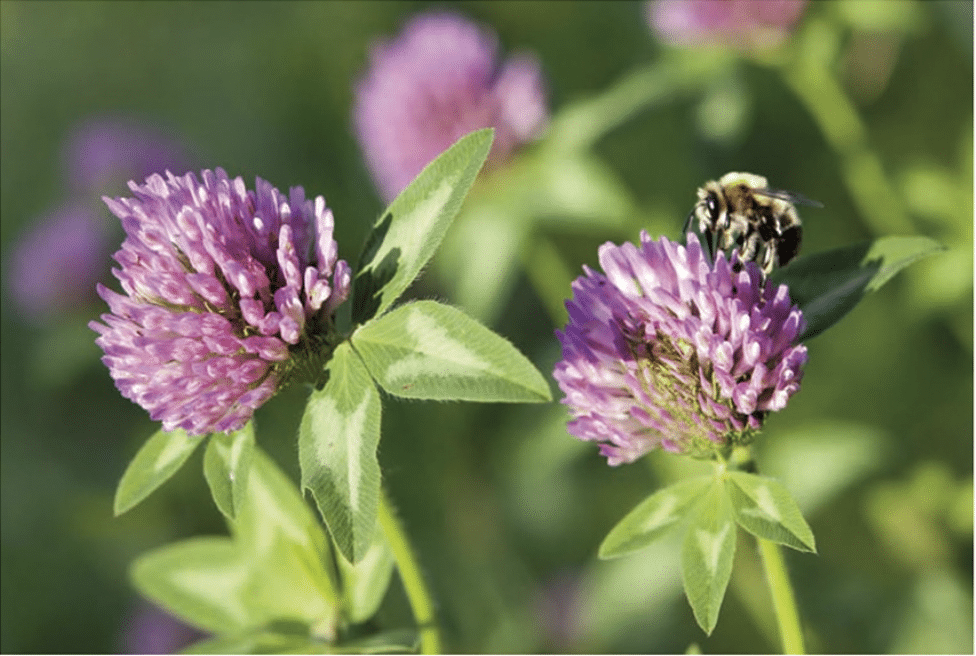
Honey bees (Genus Apis)
Honeybees of the genus Apis are truly social bees, and arguably occupy the top of the bee evolutionary tree. They form large perennial colonies consisting of a single queen, who may live for several years, male drones present for the summer season, and many sterile workers whose life span varies from a few weeks to many months. These large and complex colonies need large stores of food to survive through periods of shortage or cold weather. All species build combs made of wax secreted by the workers, taking the form of hexagonal cells arranged in one or more vertical combs.
1. European Honey bee (Apis mellifera)
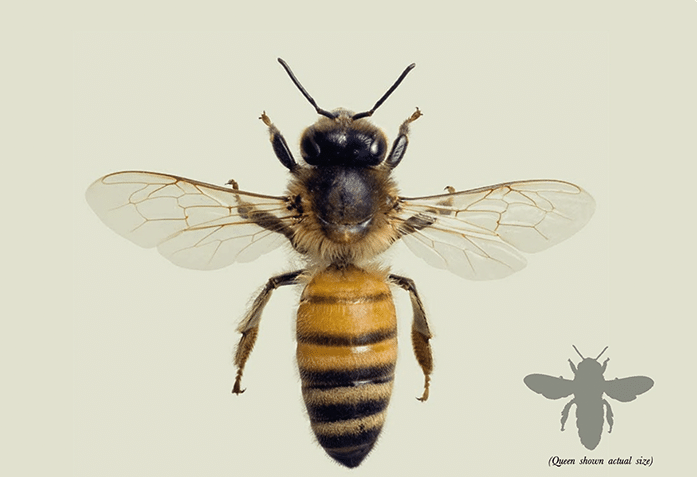
Native to: Europe, Africa, and much of Asia, and has been introduced to all continents except Antarctica
Number of Species: There are 25-30 distinct subspecies, divided into several groups- generally agreed to be the African lineage (Al, the west and north European lineage (M), the southeast Europe lineage (C), the Near and Middle Eastern lineage (0), and a fifth found only in Ethiopia (Y)
Size: The body length of a queen honeybee is 0.96 – 1.00 inches. The body length of a worker bee is 0.81 – 0.85 inches. The body of a male honeybee is 0.47 – 0.51 inches.
Food Plants: Honeybees are possibly the most generalist apis, as they feed on plants from many families.
Description: The color of a European Honeybee is variable, from black to yellow, but often with orange and black stripes. Size varies only a little between subspecies.
Behavior and Life Cycle: These are social bees, with colonies that may number more than fifty thousand workers at the height of summer. It is the most widely used commercial pollinator. In the wild, a European Honeybee nests in cavities such as hollow trees, but it is very adaptable and will occupy a range of other cavities, including many designs of artificial beehives. Subspecies vary in aggression, with some African races being very aggressive. Some races, such as those from southern Africa, swarm readily in times of dearth and are less easy to manage than the European races.
2. Asian Honey bee (Apis cerana)
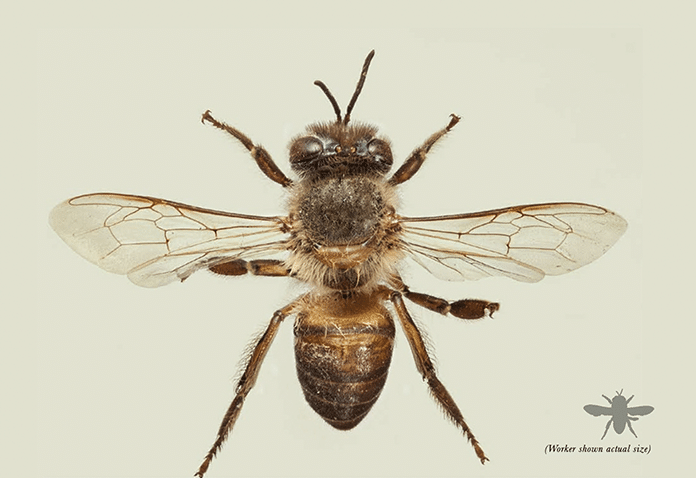
Native to: South and Southeast Asia
Size: The body length of a queen is 0.85 – 0.89 inches. The body length of a worker is 0.39 – 0.75 inches. The body length of a male is 0.39 – 0.47 inches.
Food Plants: The Asian Honeybee is a generalist species, feeding on plants from many families.
Description: Asian Honeybees are similar to the European Honeybee, but slightly smaller and variable in color. There are generally thought to be eight subspecies, two of which are used for beekeeping in India.
Behavior and Life Cycle: This species has an advanced dance communication system, but there are slight variations in the dances. Natural nest sites are cavities such as hollow trees. These bees can be kept in wooden hives for honey production, but their natural migratory behavior makes them prone to absconding. When a hornet tries to enter the hive, large numbers of bees cluster around the intruder, forming a ball that rapidly heats to 117°F (47°C), killing the hornet but without harming the bees. Other behaviors include “shimmering” at the hive entrance to deter hornets from landing.
Bumble Bees (Genus Bombus)
Bumble bees are all members of the family Apidae and are placed in the tribe Bombini. They are social bees found throughout the northern hemisphere and South America, and there are about 250 species worldwide. Most species are temperate, although a few are tropical. Bumble bees are adapted to a temperate climate, are large and furry, and are capable of flying in cool conditions.
3. Garden Bumble Bee (Bombus hortorum)
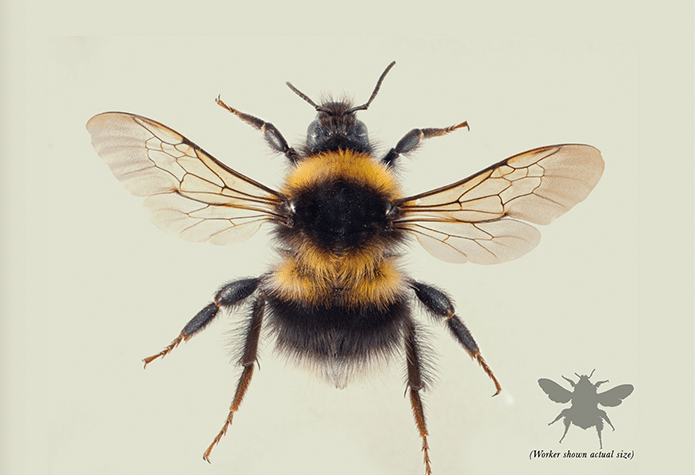
Native to: Europe as well as parts of Asia and New Zealand
Size: The body length of a queen garden bumble bee is 0.67 – 0.79 inches. The body length of a worker garden bumble bee is 0.43 – 0.63 inches. The body length of a male garden bumble bee is 0.55 – 0.59 inches.
Food Plants: Garden bumble bees are long-tongued, specializing in red clover, foxglove, honeysuckle, and many other plants.
Description: A black bumble bee with three lemon-yellow stripes (two on the thorax, one on the abdomen) and a white tail. Male, queen, and worker all share this coloration, although the male has a yellow head. Only rarely are all-black bees found. This bee is distinguished from similar species by its long, narrow face. Its very long tongue (up to 0.79 inches/20 mml often protrudes as the bee flies between deep flowers such as foxgloves. Older workers often have a shiny thorax, where the hair has rubbed off against the nest.
Behavior and Life Cycle: Garden bumble bees form short-lived colonies of up to a hundred workers during the summer, nesting in old small mammal nests, shallow scrapes, under tree roots, etc., but no deeper than 20 inches (500 mm) below the surface. These bees will also nest in man-made locations such as in buckets, under sheds, or in compost bins. The queen provisions her nest with supplies, including honey pots of stored nectar and pollen. Males patrol an area, no more than 3 feet (1 m) above ground, scenting it with pheromone to attract the young queens as possible mates. This bee’s nest is parasitized by the cuckoo bee Bombus barbutellus. The Garden Bumble Bee is a placid bee, more likely to wave its mid-leg as a warning than to sting.
4. Common Eastern Bumble Bee (Bombus impatiens)
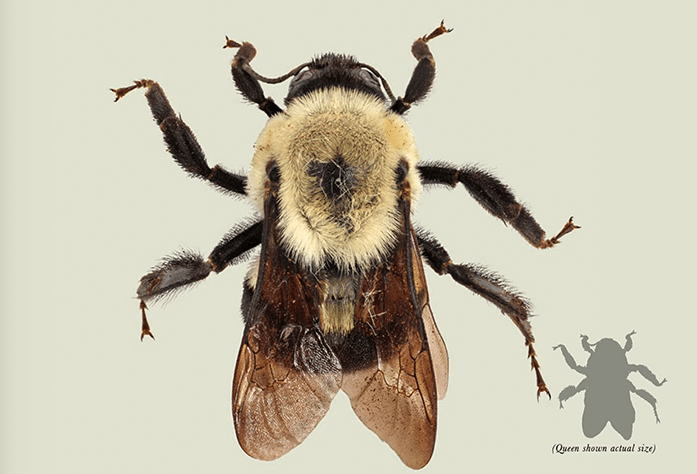
Native to: This is a common generalist bee of many rural and urban habitats, from the cold of Canada and Minnesota to subtropical Florida. Spreading westwards and southwards in the USA.
Size: The body length of a queen is 0.83 inches. The body length of a worker is 0.63 inches. The body length of a male is 0.67 inches.
Food Plants: Visits a wide range of wildflowers and garden plants; typically seen on goldenrod in late summer and fall.
Description: A black-brown bee with golden fur on the thorax and black hairs on the head, abdomen, and legs. Worker bees closely resemble the queen but are smaller. The male has some golden hairs on his face but is otherwise like the other castes.
Behavior and Life Cycle: This eusocial bee has very large colonies and nests above and below ground, often using disused rodent holes or grassy tussocks. It has a long flying season, typically March to November, but is seen as early as January and February in Florida, where it has a short or minimal overwintering period. They pollinate outdoor crops such as soybean, sunflower, and field beans, as well as fruit and nut crops.
Related: “Everything You Need To Know About the Bumble Bee”
Solitary Bees
We know surprisingly little about most species of solitary bees, although they do make up the largest group of bees by far! In Latin America and Australia, many species have yet to be identified and sometimes, sadly, a new species is identified only to be immediately declared extinct. The solitary bees that we know most about are those that impact humans in some way or those that are easy to find.
5. Violet Carpenter Bee (Xylocopa violacea)
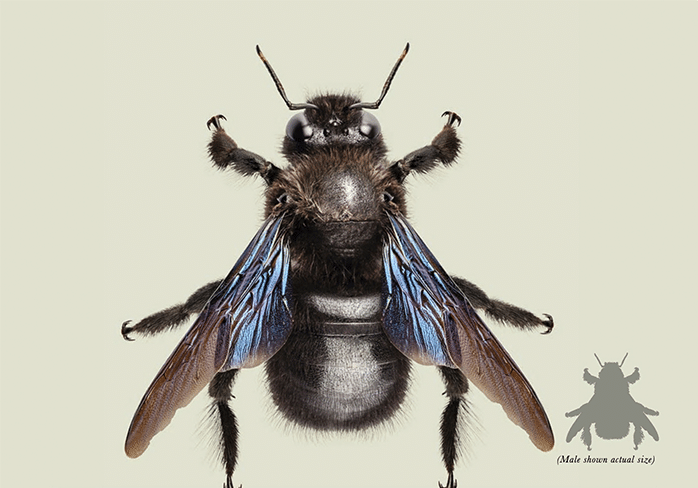
Native to: Europe
Size: The body length of a female is 0.79 – 0.94 inches. The body length of a male is 0.79 – 0.83 inches.
Food Plants: The Violet Carpenter Bee visits a wide range of pollen and nectar sources, including knapweeds, everlasting pea, daffodil, fruit trees, and more.
Description: These large bees, belonging to the family Xylocopinae, are black with dark wings, which in bright light shine purple or blue. They look brown in poor light. The abdomen is hairless. Females have black antennae but male antennae have two orange-red segments near the tip. Males are smaller and occasionally dwarf.
Behavior and Life Cycle: A nectar robber, this bee is active from February to June, raising one and sometimes two broods each year. They nest from April in deadwood, grass stems, or bamboo canes. They also nest in wooden houses and are sometimes regarded as pests. The males emerge first. After a few days of foraging, they patrol several times a day in search of females. Some males are territorial and will pursue any intruders for a distance of 135-165 feet (40-50 m). Should a male encounter a female during his patrol, he will mate. Males and females may both have multiple matings. The mated female excavates a tunnel tilled with a line of brood cells. She completes one cell before starting the next. She makes à pollen and nectar paste, onto which she lays a single egg, 0.4-0.5 inches (9-12 mm) in length. She seals the chamber with saliva. Females defend their nests, emitting intermittent buzzes or flying at the intruder. They are not aggressive to humans and rarely sing.
Related: “Everything You Need To Know About the Carpenter Bee”
6. Hairy-Footed Flower Bee (Anthophora plumipes)
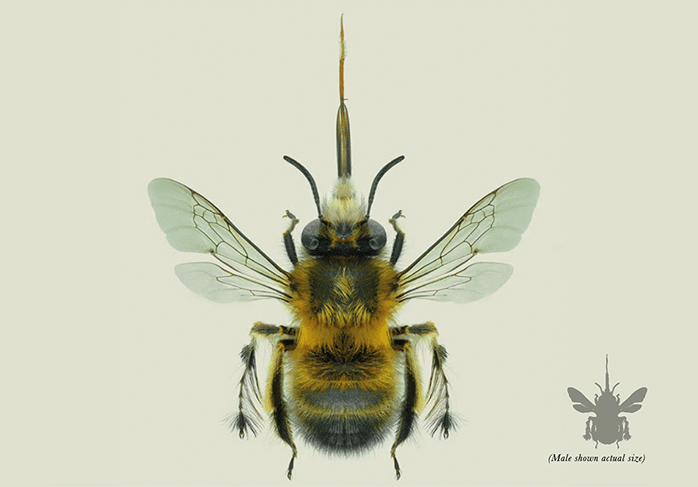
Native to: Northern Europe and Asia
Size: The body length of a female is 0.51 – 0.59 inches. The body length of a male is 0.51 – 0.59 inches.
Food Plants: This solitary bee feeds on many spring flowers, including primrose, lungworts, borage, deadnettles, broad bean, and rosemary.
Description: Densely furry, and both sexes are distinctive. In the UK, the males are usually orange-brown, but elsewhere they are gray or black. The lower part of the male’s face is yellow, and he has distinctive long black hairs on his elongated mid legs. Females are either black or brown with yellow hairs on their hind legs. The wide range of colors has led to this bee being classified as several different species–but it is now recognized as a single species, in the family Apidae (tribe Anthophorini). It is also known as the plume-legged bee.
Behavior and Life Cycle: These are fast-flying solitary bees. Males hibernate over winter to emerge in late February or March, with females emerging a few weeks later to mate and nest. The males are highly territorial and will chase off any intruders from their area, which will include forage and a suitable nest site. The females form long nest holes in clay banks, mud walls, or soft mortar. The nest is subdivided into a sequence of cells, each containing a pollen and nectar mass on which is laid a single egg. The life cycle is completed by the end of June.
7. Southeastern Blueberry Bee (Habropoda laboriosa)
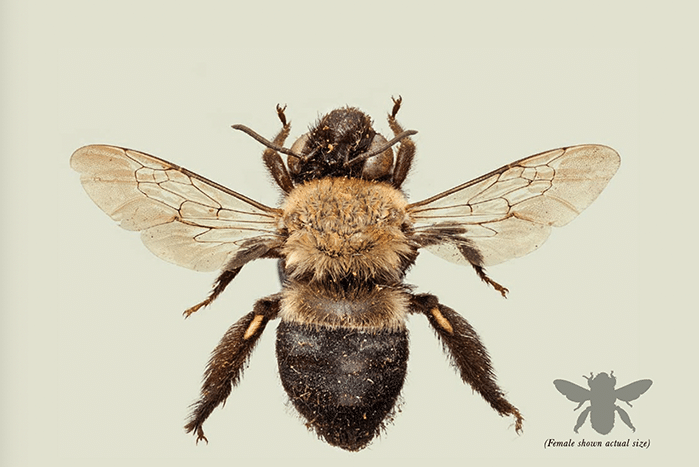
Native to: Urban, suburban, and rural areas along the East Coast in the United States.
Size: The body length of a female is 0.59 – 0.63 inches. The body length of a male is 0.51 – 0.55 inches.
Food Plants: Blueberry, but they will also visit other unrelated species for pollen and nectar including Gelsemium, Quercus, Cercis, and more.
Description: The female is black with pale fur on her thorax and black fur on her head. underside of thorax, and legs. The male is similar but has white fur on his face.
Behavior and Life Cycle: This member of the family Apidae (tribe Anthophorini) is active from late February until late May. In Florida, they are seen from November to February. Their flight period matches the three- to five-week flowering period of the blueberry (Vaccinium spp.), which they buzz-pollinate. A single brood is produced each year. The males emerge up to eighteen days before the females. They fly in a zigzag pattern above the nest sites and form a mating clump around a virgin female on the ground. The mated female scrambles out to excavate a multi-chambered nest. The main shaft slopes down to two oval nest cells. They are lined with a thin protective waxy coating that permeates the cell walls. One-third of each cell is filled with a pasty pollen mass, upon which a single egg is laid, and the cell is capped with a waxy coating. The nest is left unplugged. By August, the nests contain prepupae. It is not known which developmental stage overwinters. Burrows may be single or grouped under forest litter, in open sand, or in earthen holes. Nests may be abandoned if they are raided by Argentine ants.
8. Squash Bee (Xenoglossa fulva)
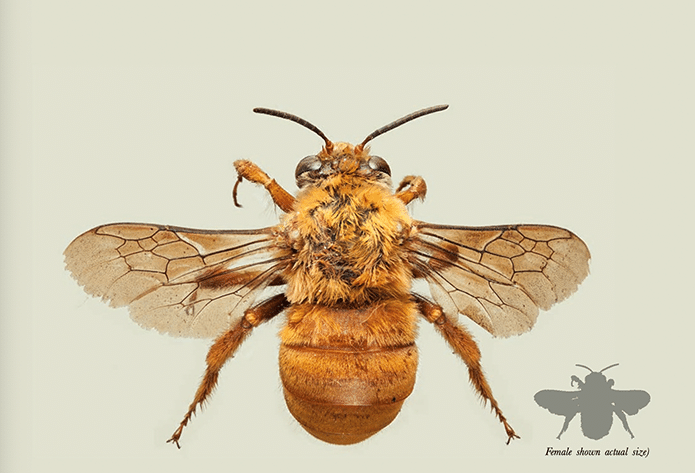
Native to: Mexico, and are found wherever squashes are grown.
Size: The body length of a female is 0.55 – 0.71 inches. The body length of a male is 0.55 – 0.63 inches.
Food Plants: Squash
Description: These bees have unusually large ocelli, typical of bees that fly when light levels are poor. They are black with golden red-brown legs and dark feet. They have long, dense pale golden fur and yellow-brown wings. They are members of the family Apidae (tribe Eucerini) but–unlike Peponapis species–the male has a black face and the female has a yellow face.
Behavior and Life Cycle: Squash flowers open before dawn and wither until closed by noon. These bees are active when the flowers are open, foraging and mating before noon. They often shelter in the closed flowers and must cut or tear their way out of the dead bloom. The female nests in loam soil in open grassland amid an aggregation of burrows from earlier years. She digs a vertical shaft, with a mound of excavated soil up to 4 inches (10 cm) tall around the entrance. Oval nest cells are formed off the main shaft. Each cell is lined with a protective substance and one-quarter filled with pollen mass and a thin laver of nectar. A single egg is then laid on top. The cells are capped and the burrow is plugged. The developing bees overwinter as larvae, transforming into adults during June/July, shortly before emergence in August.
9. Sweat Bee (Augochlorella aurata)
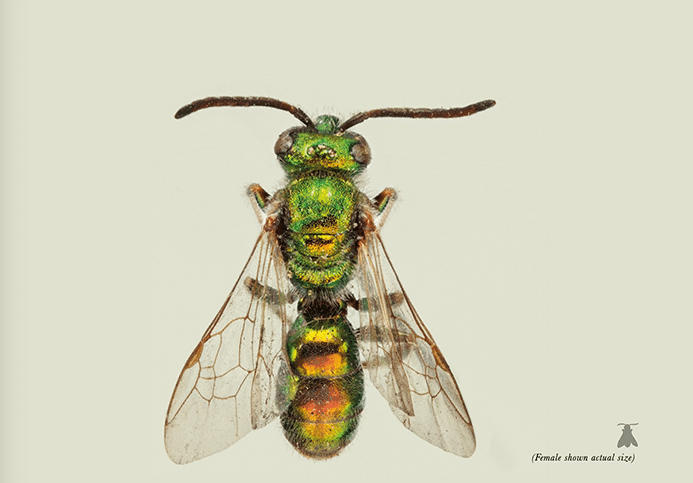
Native to: North America, extending from the mountainous regions and central plains to the East Coast lowlands.
Size: The body length of a female is 0.20 – 0.24 inches. The body length of a male is 0.20 inches.
Food Plants: Prickly pear, swamp smartweed, blackberry, and aster.
Description: The female is bright green to yellow-green or coppery-green, with golden-white hair on the back of the head, thorax, legs, and abdomen and white hair on the face and front of the body. The male is brilliant green or coppery red.
Behavior and Life Cycle: This primitively eusocial bee (family Halictidae, tribe Augochlorini) is active from May to November. The mated female or foundress builds a nest, often in aggregation, in a grassy embankment or south-facing slope, and provisions the cells for her first brood. On average, seven eggs are laid. The female young emerge as workers, and they are mostly sterile. The foundress lays more eggs, relying on her daughters for food and to nurture the developing brood. This second brood develops into a reproductive population of males and females. They emerge in late summer and mate. Only the mated females overwinter. Rarely. a nest has two small co-foundresses, who produce twice the amount of brood. They divide duties. with one foundress laying eggs while the second forages, despite being a mated female. Should the foundress queen die before the second brood is produced, one of her daughters becomes a replacement queen. Nests produced at the most northerly parts of the sweat bees range tend to be less social, with few or no workers produced by the mated female.
10. Mason Bee (Osmia cornuta)
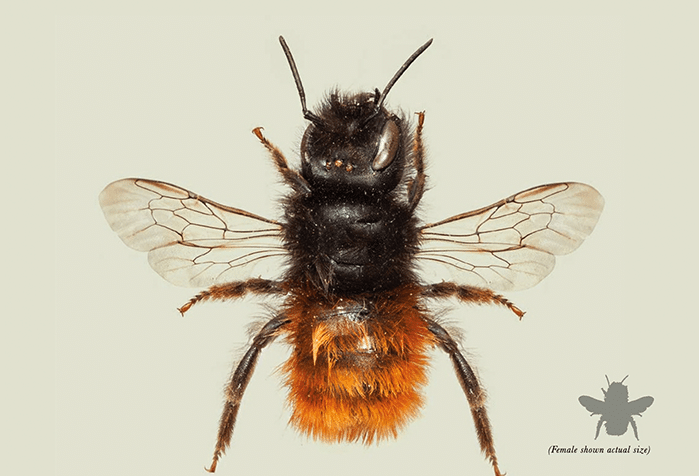
Native to: Europe
Size: The body length of a female and male is 0.39 – 0.59 inches.
Food Plants: This bee visits a wide variety of plants for pollen and nectar, especially fruit trees such as apple, almond, plum, and pear.
Description: The female is a black bee with an orange abdomen and feet, black fur on her face and thorax, and long red-brown hairs on the abdomen. The males are similar but have white fur on the face and a black abdomen with long orange hairs.
Behavior and Life Cycle: Like most mason bees (family Megachilidae, tribe Osmiini), this species prefers to nest in pre-existing cavities. Males emerge first. A newly mated female may build up to seven nests with a series of brood cells separated by mud partitions. Female eggs are laid first and provided with larger stores of provisions of nectar and pollen. Eggs hatch a few days after they are laid in February/March but the larvae are not ready to pupate until August/September. They reach the adult stage but do not emerge. Instead, they go into diapause and spend the winter in their cells. Mason bee nests are often invaded by pests and predators.
Related: “Everything You Need To Know About Mason Bees”
11. Tawny Mining Bee (Andrena fulva)
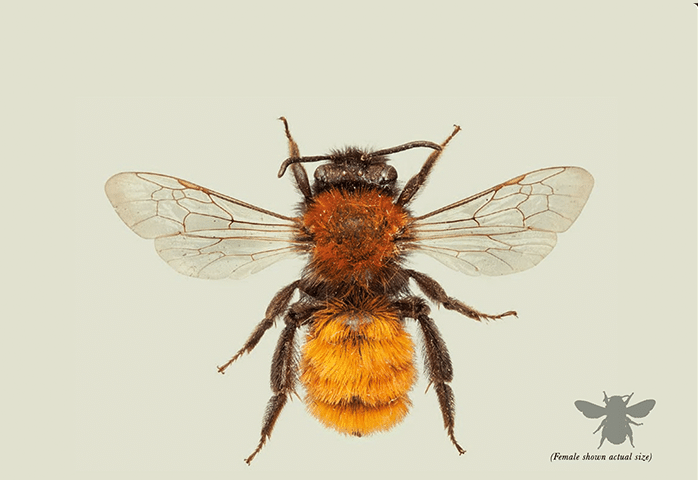
Native to: Europe. Widespread and common in parks and gardens, including lawns, flower beds, and mown banks.
Size: The body length of a female and male is 0.39 – 0.55 inches.
Food Plants: A wide range of plants including weeds, garden plants, shrubs, and trees.
Description: The female has long, dense, bright reddish hairs on the back of the thorax and abdomen. The rest of her body and head are covered with black hair. The male is slimmer and dull brown, with sparse reddish-brown hairs and a tuft of white hairs on the lower face.
Behavior and Life Cycle: This is another member of the Andrenidae family. A single brood is produced between late March and mid-June. The nests are placed in large aggregations. Bees fly out in the spring, from early April until early June, when apple, pear, and cherry trees are in flower. The males emerge first. Flying in zigzag patterns, they seek newly emerged females. The males can mate repeatedly but the females only mate once. The mated female excavates up to three nest burrows in level soil, leaving a mound of soil at each nest entrance, with the main shaft dividing into four or five side tubes. She waterproofs the walls with terpenoid secretions smoothed by her pygidial plate. Into each tube, a single egg is laid. The brood develop into adults and overwinter in their cells. The tawny mining bee does not sting.
Stingless Bees
Stingless bees are distributed through the tropics in Australia, Asia, Africa, and the Americas (where 75% of species are found). Like honeybees and bumble bees, they are members of the Apidae family, but they belong in a separate subdivision, the Meliponini tribe. There are over 500 known species, and many more remain to be described. Considering their diversity and economic importance, the stingless bees remain understudied!
12. Royal Lady Bee (Melipona beecheii)
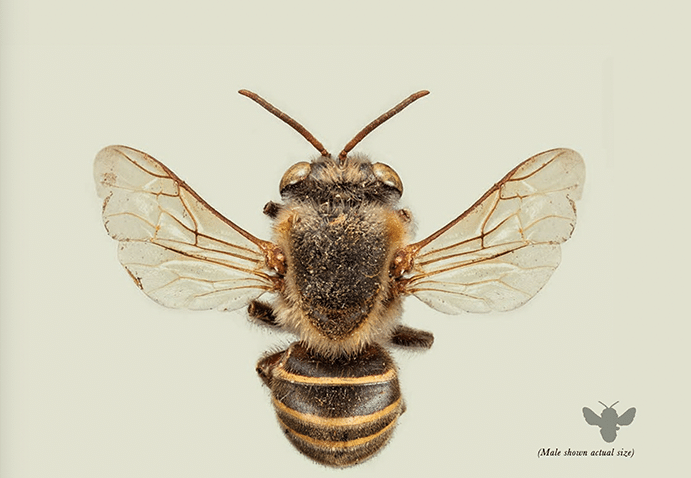
Native to: Mexico. Found in tropical and subtropical lowland rainforest and dry forest. Threatened species.
Size: The body length of a queen is currently unknown. The body length of a worker is 0.39 inches. The body length of a male is 0.35 inches.
Food Plants: Visits a wide range of plants, including Apocynaceae, Cassia emerginata, Cordia gerascanthus, and more.
Description: A brown bee with golden bands across the abdomen and reddish-brown legs. They have pale gray fur on the head, thorax, and legs. Hair is sparse on the abdomen.
Behavior and Life Cycle: These bees nest in tree cavities in mature forests. They are also kept in hollow logs or man-made boxes. Within the cavity, they make stacks of dark wax comb. Storage pots for honey and pollen are built on the edges of the nest, attached to the wall of the hive. They are sealed when full. They do not feed their larvae but provision the brood cells with pollen and honey stores. The queen lays an egg on top of the stores and the cell is sealed. Worker bees help the young bee to emerge, cutting away the wax capping so that the young bee can climb out from its papery cocoon. Workers are specialists when foraging. Even though nectar and pollen foragers make the same number of flights, their life spans differ. Nectar gatherers were observed to be active all day but to die after three days, whereas pollen gatherers only worked for one to three hours per day and lived for twelve days. This bee buzz-pollinates flowers and is not aggressive.
13. Sugarbag Bee (Tetragonula carbonaria)
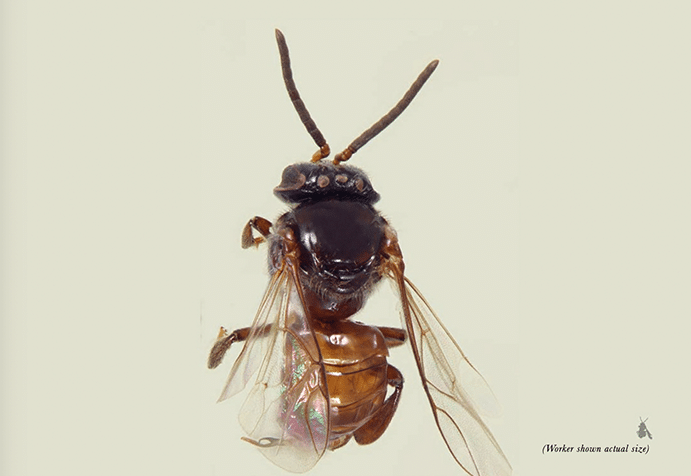
Native to: Northeast coast of Australia. Common in gardens, community gardens, orchards, forests, and coastal regions.
Size: The body length of a queen is 0.28 inches. The body length of a worker is 0.6 inches. The body length of a male is 0.16 inches.
Food Plants: Seen on a wide range of native plants including eucalyptus, Callistemon, cycads, plus fruit trees and non-native garden plants such as sunflowers.
Description: The jet-black females have sparse hair on the top of the thorax and short dense hair on the sides of the thorax. The males look similar but are dark red-brown.
Behavior and Life Cycle: The nest is made of wax and resin, with the brood cells set in a spiral comb. It is built in a tree cavity or a man-made box. The bees forage within 80 feet (25 m) of the hive, visiting a wide range of plants. These bees deal with the small hive beetle and other parasites by coating the invader in batumen, a resin and wax mixture. They only cease their attack when the beetle stops moving; it then shrivels and dies–in effect, it is mummified. They can also defend the nest aggressively. Sugarbag workers may form “fighting swarms,” ” in which thousands die in battle when one colony attempts to invade or rob the nest of another. The battle rarely takes place in the nest itself–thereby protecting the brood and stores–but the defenders form a fighting swarm and take on the invaders some 6 feet (2 m) from the nest. Humans keep these bees in natural logs or hives in towns and gardens. Their honey is marketed as “sugarbag honey.”
14. Iratim Bee (Lestrimelitta limao)
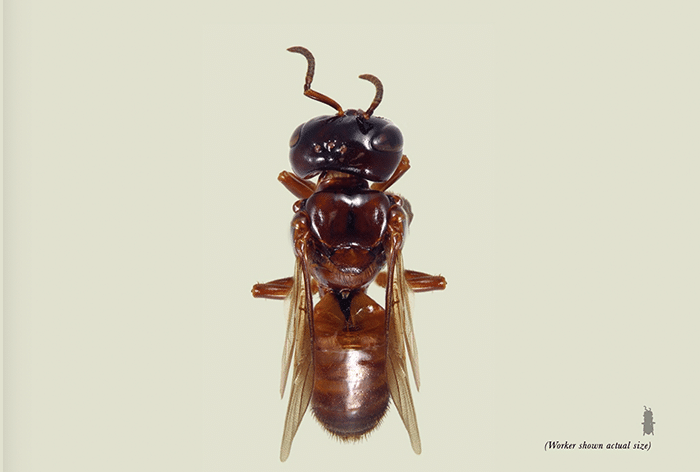
Native to: South America. Widespread in the semi-arid desert known as white forest, with cacti, small thorny trees, and scrub.
Size: The body length of a queen is unknown. The body length of a worker is 0.24 inches. The body length of a male is unknown.
Food Plants: This bee does not visit plants for food.
Description: A slender dark black-brown bee with red-brown feet, sparsely hairy on the thorax and legs.
Behavior and Life Cycle: This bee has lost the ability to seek its own food. It has no pollen basket and must parasitize jetai and other bee species, including honeybees. It raids the other bees’ nests for pollen and honey, and may also collect plant resins and cerumen (a mixture of wax and resin) from the raided nest. The attack weakens and often kills the invaded colony, due to loss of food stores and losses of larvae and adults. During the raid, L. limo releases citral, an alarm pheromone. When raiding bees are killed, yet more citral is released, attracting increasing numbers of robber bees. As the odor pervades the target colony, it also disorientates the host species, leaving them unable to form a cohesive defense. This bee builds its own nest in a natural crevice or cavity, where it stores the raided mixed pollen and honey in pots. It has hollow tubes around the nest entrance, and these blind tunnels seem to be a defense against attack by rival colonies. These bees can fight over potential nesting sites, with battles often costing many robber bees lives. These battles regulate the density of the local robber bee population.
Honey Bee Hive Hierarchy: The 3 Roles in a Hive
While the list above highlights just a few of the different types of solitary, stingless, and bumblebees, the honeybee is the most studied, and most familiar! Within one honeybee hive, there are three different bee roles that all come together with specific duties for the health and success of the colony.
The queen bee is a sexually reproductive female inside the hive, and typically there is only one queen per nest in social bee species. A queen bee has exactly the same genes as a worker, but she develops into a queen because she is fed extra rations of royal jelly when she is a larva. The main duty of a queen bee is to lay eggs and produce pheromones, a chemical scent that helps regulate the colony. The queen is larger than the workers, longer than drones, and she lives for multiple years.
A worker bee is a female bee that is not capable of sexual reproduction, and this type of bee makes up most of the population within a hive. A worker bee’s first duty is inside the nest, cleaning and nursing the brood, before she moves on to guarding the entrance, and eventually to foraging for pollen and nectar. Foraging takes a severe toll on the worker bee’s body, clearly visible in the shredding of her wings. In the summer, a worker honeybee lives only about a month as an adult, but in the inactive winter season, she might live for three to six months.
A drone is a male bee and is not capable of stinging or making honey. A drone’s main purpose within a hive is to mate with the queen, and they can live for three months, or until they finally mate. Drones are larger than workers and have bigger eyes and wings than either a queen or worker bee.
How to Attract Different Types of Bees
Without the help of bees, we would lose one out of every three bites of food we eat, so attracting them to a garden is incredibly important for our own wellbeing, in addition to theirs! There are various ways that people can attract bees, but overall these insects are looking for two key things when they visit plants: nectar and pollen. According to The Spruce, nectar is loaded with sugars and is a bee’s main source of energy, while pollen provides a balanced diet of proteins and fats.
To attract more bees to your garden, incorporate the following best practices:
- Plant a variety. Bees love many different types of flowering plants and flowers. They’re especially fond of native wildflowers and flowering herbs. It is important to have a variety of flowering plants including types and bloom cycles. If your plants have successive blooms, honeybees are more likely to return to collect nectar and pollinate your garden.
- Include a water source. Like every hard worker, bees need access to food and fresh water to survive. When providing a water source for your bees to drink from, it is important to know that bees are much better fliers than they are swimmers. Therefore, bees need a dry place to stand while drinking. Shallow dishes, birdbaths, and a few rocks can also be used as water sources if your space doesn’t allow for a garden pond.
- Avoid chemical fertilizers. Most sustainable gardeners already refrain from using chemical pesticides, herbicides, and weed killers. If pests are found in your gardens, consider using natural pest controls such as mulch. Pesticides are extremely harmful to your bees. The use of eco-friendly options greatly reduces the honeybee mortality rate.
For more tips on how to attract bees to your garden, read our blog “The Best Bees Checklist For A Bee-Friendly Garden”.
How to Help Support the Health of All Types of Bees
When it comes to saving all bees, and not just honeybees, there are multiple ways that anyone can get involved.
First, consider making a home for bees! Even a window box can be a substitute for lost habitats. Plants with single and open flowers are a good choice, but try to avoid highly bred double and fancy flowers, which may produce nothing for the bees and the nectar and pollen could be out of reach.
Another way to ensure the protection of all bee species is to limit your usage of fertilizer and pesticides. Pesticides are commonly used in agricultural areas to control pests and disease carriers as well as control weeds–but the impact on bees is deadly. A recent study that examed the effects of neonicotinoid pesticides in Canada and Europe found that while the use of this pesticide doesn’t obliterate the colonies outright, it does “kill them over extended periods of time. The pesticides also threaten bee queens in particular–which means colonies have lower reproductive rates.” Since bees are attracted to many types of blooming flowers, consider avoiding the use of harsh chemicals and instead allow for your yard to turn into a meadow that all pollinators can enjoy.
The political consensus is yes, we should do what we can to help the bees, yet in times of recession, governments seek to minimize cost which means implementing effective bee-friendly measures doesn’t always happen. So to advocate for pollinators, make your voice heard by continuing to remind national, regional, and local governments of the importance of all bee species.
Lastly, one of the most impactful ways we can all contribute to the study and protection of bee populations is by hosting a beehive on your property. Whether you live or work in an urban or rural setting, The Best Bees Company can help you install and manage a data-yielding beehive, which allows you to directly contribute to the research that is being done to improve the health of bees nationwide.
FAQs
Q: How many bee species are there?
A: There are an estimated 20,000 species of bees.
Q: What types of bees exist?
A: Out of the 20,000 different species of bees, 250 are bumblebees, 500-600 are stingless bees, and 7 are honeybees. The remainder are the solitary bees.
Q: How can I identify a bee?
A: You can identify a bee by looking at its shape, color, size, behavior, and habitat.
Q: What’s the difference between a bee and a wasp?
A: Bees are often mistaken for wasps because they share similar visual characteristics, but unlike wasps which tend to be aggressive, bees will sting only if their colony is threatened or they are being squashed.
Q: How can I attract more bees to my garden?
A: There are many ways to attract more bees to gardens including planting a variety of flowering plants, creating a water source for the bees, avoiding the use of harsh chemicals and pesticides, and even creating bee hotels.




